Uncategorized
A group of Israeli emissaries toured a Palestinian museum in DC, and came away with questions
WASHINGTON (JTA) — For Rotem Yerushalmi, a professional campus pro-Israel advocate, what stood out during a recent visit to the Museum of the Palestinian People was an exhibit showcasing different villages’ ceremonial dress.
She strolled past references to the Nakba, which means “catastrophe” and denotes the dispersion of Palestinians during Israel’s War of Independence. And she gazed upon a photograph of an elderly man clutching the key to the dwelling his family left amid that year’s Arab-Israeli war. None of those surprised her.
“The references to the key, the Nakba, were very familiar,” Yerushalmi said. “But the garb! I didn’t know they had different dresses for different areas.”
Yerushalmi was part of a delegation of about 20 Israeli emissaries stationed at U.S. universities that visited the museum late last month. It was the first-ever tour the museum had organized for a group of Israelis.
Like most Jews in Israel, many of them had relatively few interactions with Arabs inside the country, and learned little about Palestinian culture and history in school. But here at the Washington museum, located just a mile from Yerushalmi’s post at Georgetown University, they got a view into a society that is both largely off-limits to them and entwined with their country’s future.
“It’s important because it humanizes each other, I think, for Israelis to hear the Palestinian perspective,” said Bshara Nassar, a Palestinian from Bethlehem who founded the one-room museum in 2019. “Actually having a wall that separates Palestinians from Israelis — there is no way, there is no place to interact.”
The tour was the brainchild of Jonathan Kessler, the former longtime head of student affairs at the American Israel Public Affairs Committee, the pro-Israel lobby. He now helms Heart of a Nation, which organizes people-to-people encounters between young Israelis, Palestinians and Americans — and which marks a turn away from the pro-Israel advocacy he once championed.
“For the first time, maybe in my lifetime, you’ve got young people from all three societies who simultaneously recognize that their politics is stuck and they desperately want to push forward into a better place,” he told the Jewish Telegraphic Agency.
He worries that unless they move beyond their “narrow communal silos,” young Jews in the United States “will further distance themselves from Israel, young Israelis will turn their back on the pursuit of peace with the Palestinians, and young Palestinians will give up on coexistence with Israel.”
Recommending a tour of the museum, he said, was a way to make that happen. The Jewish Agency for Israel’s Campus Israel Fellows, which brought the emissaries to Washington, D.C., asked him to recommend museum tours for the group, and he suggested the U.S. Holocaust Memorial Museum, the National Museum of African American History and this tiny, barely known institution.
Mohammed El-Khatib, a docent at the Museum of the Palestinian People, leads a group of Jewish Agency emissaries through the museum in Washington, D.C., March 22, 2023. (Ron Kampeas)
For at least some of the emissaries, the visit had Kessler’s intended effect. Mohammed El-Khatib, the group’s docent, described his experience as a Lebanese-born Palestinian refugee, and told of his family’s flight from their ancestral village during Israel’s War of Independence.
“It opens our mind to hear his perspective, to hear him say that he’s Palestinian, but he’s never been to Palestine, he was born in Lebanon, but he identifies as a Palestinian,” said Lielle Ziv, who works at Cleveland Hillel. “He told a story, and not like, right or wrong, it’s not a black-and-white situation. We can both be right,”
The museum is nestled in a townhouse adjacent to a pet care outlet, a Middle East bookstore and a chocolatier. A similar and larger museum in the Palestinian West Bank city of Birzeit, called the Palestinian Museum, is in territory that is off-limits to Israelis.
At the Washington museum, there was a lot of common ground: A Kurdish Israeli emissary said the keffiyeh in one exhibit reminded him of pictures of his male relatives, who wore similar headdresses before they left Iraq for Israel. El-Khatib was pleased to learn that the Arabic name for Hebron, Al Khalil, has the same meaning as the city’s Hebrew name — a “friend of God.”
One of the Israelis recognized the British Mandate passport on display, which once belonged to a Palestinian woman. His grandmother had one that was identical, he said.
When El-Khatib greeted the group, he said “Marhaba, Shalom,” respectively the more formal Arabic and Hebrew terms of welcome, and the group spontaneously answered with “Ahalan,” a less formal Arabic greeting that is commonplace among Israelis. That delighted El-Khatib.
The group was similarly pleased when he showed off some Hebrew phrases in a pitch perfect Israeli accent, which he said he learned from an Israeli ex-boyfriend. The group then pushed him to spill more details about his ex.
“In campus encounters we’re always kind of on duty,” said Nati Szczupak, the director of the Campus Israel Fellows program. “They’re on duty, right? They’re pro-Palestine. We’re pro-Israel. And it’s very rare that you can just talk and get to those moments of like, ‘Hey, I used to wear that hat too, when I was little.’”
She was referring to an exhibit on different types of Palestinian headwear that included a fez, or traditional Moroccan hat, which elicited a squeal of delight from a Moroccan Jewish emissary who said she had a photo of herself as a toddler sporting one of her ancestors’ fezzes.
“It’s not about facts,” Szczupak said. “We know the facts. What about the narrative? What is your story? We’re not arguing about the facts, but how we experienced them.”
The museum’s exhibits include photographs of Palestinians in Israel, the West Bank and in exile, and are marked by contrasts: images of resistance — of a small boy throwing stones — and of the mundane — of young men playing soccer. Arrays of black-and-white photos from the late 19th and 20th centuries feature celebrations juxtaposed with resettlement in refugee camps.
A case includes Palestinian glassware, pottery and headwear throughout the ages. There was a temporary exhibit of line drawings by a contemporary Palestinian artist, and a wall titled “Making their mark” of prominent Palestinians — including Rashida Tlaib, the Democratic congresswoman from Michigan; the late Edward Said, the literary critic and scholar; the sisters Gigi and Bella Hadid, who are models; and DJ Khaled, the rapper.
The museum does not hold back from addressing the Israeli-Palestinian conflict. The conflict’s most vexing issue — each side’s fear that the other side wants to replace it — was most evident in the museum’s maps: One depicted the scattering of the Palestinians throughout the Diaspora, and others showed how Israel expanded its territory from the land it was given in the 1947 United Nations partition plan.
Outside the museum, while the Israelis were waiting for the tour to start, a pair of the Israel fellows examined a poster for an exhibit, “The Art of Weeping, by a Palestinian artist, Mary Hazboun. The line drawing of a Palestinian mother in a traditional dress, carrying her babies, evoked the map of the entirety of Israel, Gaza and the West Bank — and then some.
“The proportions are interesting,” one said to the other, in Hebrew. “It includes not just Israel and the West Bank and the Gaza Strip, but the Golan Heights and a part of Jordan.”
Ziv said the tour made her think that she “would like more connections” with Palestinians — and it was clear that it was easier to make those connections in Washington than it would be in Tel Aviv or Jenin. El-Khatib said he had never met an Israeli before he moved to the United States.
“When we have Palestinian visitors coming to the museum, they quickly doze off — I mean, to them, it’s more about the achievement of the space,” El-Khatib said. “But when this group came in, I really felt that they were very attentive and hanging on to every word that I said, which was wonderful.”
—
The post A group of Israeli emissaries toured a Palestinian museum in DC, and came away with questions appeared first on Jewish Telegraphic Agency.
Uncategorized
How the Global Religious Landscape Changed from 2010 to 2020

Muslims grew fastest; Christians lagged behind global population increase
• Christians are the world’s largest religious group, at 28.8% of the global population. They are a majority everywhere except the Asia-Pacific and Middle East-North Africa regions. Sub-Saharan Africa has surpassed Europe in having the largest number of Christians. But Christians are shrinking as a share of the global population, as millions of Christians “switch” out of religion to become religiously unaffiliated.
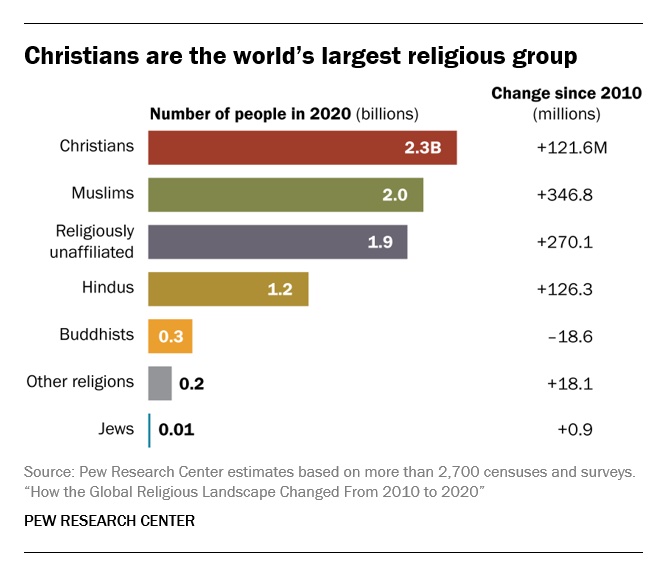
• Muslims are the world’s second-largest religious group (25.6% of the world’s population) and the fastest-growing major religion, largely due to Muslims’ relatively young age structure and high fertility rate. They make up the vast majority of the population in the Middle East-North Africa region. In all other regions, Muslims are a religious minority, including in the Asia-Pacific region (which is home to the greatest number of Muslims).
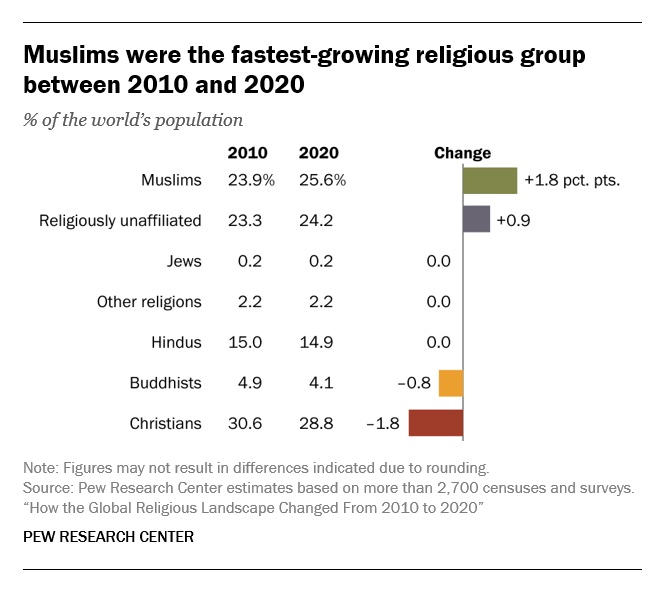
• The religiously unaffiliated population is the world’s third-largest religious category (24.2% of the global population), after Christians and Muslims. Between 2010 and 2020, religiously unaffiliated people grew more than any group except Muslims, despite their demographic disadvantages of an older age structure and relatively low fertility. The unaffiliated made up a majority of the population in 10 countries and territories in 2020, up from seven a decade earlier.
• Hindus are the fourth-largest religious category (14.9% of the world’s population), after Christians, Muslims and religiously unaffiliated people. Most (99%) live in the Asia-Pacific region; 95% of all Hindus live in India alone. Between 2010 and 2020, Hindus remained a stable share of the world’s population because their fertility resembles the global average, and surveys indicate that switching out of or into Hinduism is rare.
• Buddhists (4.1% of the world’s population) are the only group in this report whose number declined worldwide between 2010 and 2020. This was due both to religious disaffiliation among Buddhists in East Asia and to a relatively low birth rate among Buddhists, who tend to live in countries with older populations. Most of the world’s Buddhists (98%) reside in the Asia-Pacific region, the birthplace of Buddhism.
• Jews, the smallest religious group analyzed separately in this report (0.2% of the world’s population), lagged behind global population growth between 2010 and 2020 – despite having fertility rates on par with the global average – due to their older age structure. Most Jews live either in North America (primarily in the United States) or in the Middle East-North Africa region (almost exclusively in Israel).
These are among the key findings of a Pew Research Center analysis of more than 2,700 censuses and surveys, including census data releases that were delayed due to the coronavirus pandemic. This report is part of the Pew-Templeton Global Religious Futures project, which analyzes global religious change and its impact on societies around the world. Funding for the Global Religious Futures project comes from The Pew Charitable Trusts and the John Templeton Foundation.
Uncategorized
Antisemitism in some unlikely places in America

By HENRY SREBRNIK Antisemitism flourishes in a place where few might expect to confront it – medical schools and among doctors. It affects Jews, I think, more emotionally than Judeophobia in other fields.
Medicine has long been a Jewish profession with a history going back centuries. We all know the jokes about “my son – now also my daughter – the doctor.” Physicians take the Hippocratic Oath to heal the sick, regardless of their ethnicity or religion. When we are ill doctors often become the people who save us from debilitating illness and even death. So this is all the more shocking.
Yes, in earlier periods there were medical schools with quotas and hospitals who refused or limited the number of Jews they allowed to be affiliated with them. It’s why we built Jewish hospitals and practices. And of course, we all shudder at the history of Nazi doctors and euthanasia in Germany and in the concentration camps of Europe. But all this – so we thought – was a thing of a dark past. Yet now it has made a comeback, along with many other horrors we assume might never reappear.
Since the Hamas attack on Israel on October 7, 2023, there has been a resurgence of antisemitism, also noticeable in the world of healthcare. This is not just a Canadian issue. Two articles on the Jewish website Tablet, published Nov. 21, 2023, and May 18, 2025, spoke to this problem in American medicine as well, referencing a study by Ian Kingsbury and Jay P. Greene of Do No Harm, a health care advocacy group, based on data amassed by the organization Stop Antisemitism. They identified a wave of open Jew-hatred by medical professionals, medical schools, and professional associations, often driven by foreign-trained doctors importing the Jew-hatred of their native countries, suggesting “that a field entrusted with healing is becoming a licensed purveyor of hatred.”
Activists from Doctors Against Genocide, American Palestinian Women’s Association, and CODEPINK held a demonstration calling for an immediate cease-fire in Gaza at the Hart Senate Office Building in Washington, D.C., Nov. 16, 2023, almost as soon as the war began. A doctor in Tampa took to social media to post a Palestinian flag with the caption “about time!!!” The medical director of a cancer centre in Dearborn, Michigan, posted on social media: “What a beautiful morning. What a beautiful day.” Even in New York, a physician commented on Instagram that “Zionist settlers” got “a taste of their own medicine.” A Boston-based dentist was filmed ripping down posters of Israeli victims and a professor at the University of Pennsylvania Perelman School of Medicine did the same. Almost three-quarters of American medical associations felt the need to speak out on the war in Ukraine but almost three-quarters had nothing to say about the war in Israel.
Antisemitism in academic medical centres is fostering noxious environments which deprive Jewish healthcare professionals of their civil right to work in spaces free from discrimination and hate, according to a study by the Data & Analytics Department of StandWithUs, an international, non-partisan education organization that supports Israel and fights antisemitism.
“Academia today is increasingly cultivating an environment which is hostile to Jews, as well as members of other religious and ethnic groups,” StandWithUs director of data and analytics, and study co-author, Alexandra Fishman, said on May 5 in a press release. “Academic institutions should be upholding the integrity of scholarship, prioritizing civil discourse, rather than allowing bias or personal agendas to guide academic culture.”
The study, “Antisemitism in American Healthcare: The Role of Workplace Environment,” included survey data showing that 62.8 per cent of Jewish healthcare professionals employed by campus-based medical centres reported experiencing antisemitism, a far higher rate than those working in private practice and community hospitals. Fueling the rise in hate, it added, were repeated failures of DEI (diversity, equity, and inclusion) initiatives to educate workers about antisemitism, increasing, the report said, the likelihood of antisemitic activity.
“When administrators and colleagues understand what antisemitism looks like, it clearly correlates with less antisemitism in the workplace,” co-author and Yeshiva University professor Dr. Charles Auerbach reported. “Recognition is a powerful tool — institutions that foster awareness create safer, more inclusive environments for everyone.”
Last December, the Data & Analytics Department also published a study which found that nearly 40 per cent of Jewish American health-care professionals have encountered antisemitism in the workplace, either as witnesses or victims. The study included a survey of 645 Jewish health workers, a substantial number of whom said they were subject to “social and professional isolation.” The problem left more than one quarter of the survey cohort, 26.4 per cent, “feeling unsafe or threatened.”
The official journal of the Alliance for Academic Internal Medicine concurs. According to “The Moral Imperative of Countering Antisemitism in US Medicine – A Way Forward,” by Hedy S. Wald and Steven Roth, published in the October 2024 issue of the American Journal of Medicine, increased antisemitism in the United States has created a hostile learning and practice environment in medical settings. This includes instances of antisemitic behaviour and the use of antisemitic symbols at medical school commencements.
Examples of its impact upon medicine include medical students’ social media postings claiming that Jews wield disproportionate power, antisemitic slogans at the University of California, Los Angeles (UCLA) David Geffen School of Medicine, antisemitic graffiti at the University of California, San Francisco (UCSF) Cancer Centre, Jewish medical students’ exposure to demonization of Israel diatribes and rationalizing terrorism; and faculty, including a professor of medicine at UCSF, posting antisemitic tropes and derogatory comments about Jewish health care professionals. Jewish medical students’ fears of retribution, should they speak out, have been reported. “Our recent unpublished survey of Jewish physicians and trainees demonstrated a twofold increase from 40% to 88% for those who experienced antisemitism prior to vs after October 7,” they stated.
In some schools, Jewish faculty are speaking out. In February, the Jewish Faculty Resilience Group at UCLA accused the institution in an open letter of “ignoring” antisemitism at the School of Medicine, charging that its indifference to the matter “continues to encourage more antisemitism.” It added that discrimination at the medical school has caused demonstrable harm to Jewish students and faculty. Student clubs, it said, are denied recognition for arbitrary reasons; Jewish faculty whose ethnic backgrounds were previously unknown are purged from the payrolls upon being identified as Jews; and anyone who refuses to participate in anti-Zionist events is “intimidated” and pressured.
Given these findings, many American physicians are worried not only as Jewish doctors and professionals, but for Jewish patients who are more than ever concerned with whom they’re meeting. Can we really conceive of a future where you’re not sure if “the doctor will hate you now?”
Henry Srebrnik is a professor of political science at the University of Prince Edward Island.
Uncategorized
The 2025 Toronto Walk (and talk ) for Israel
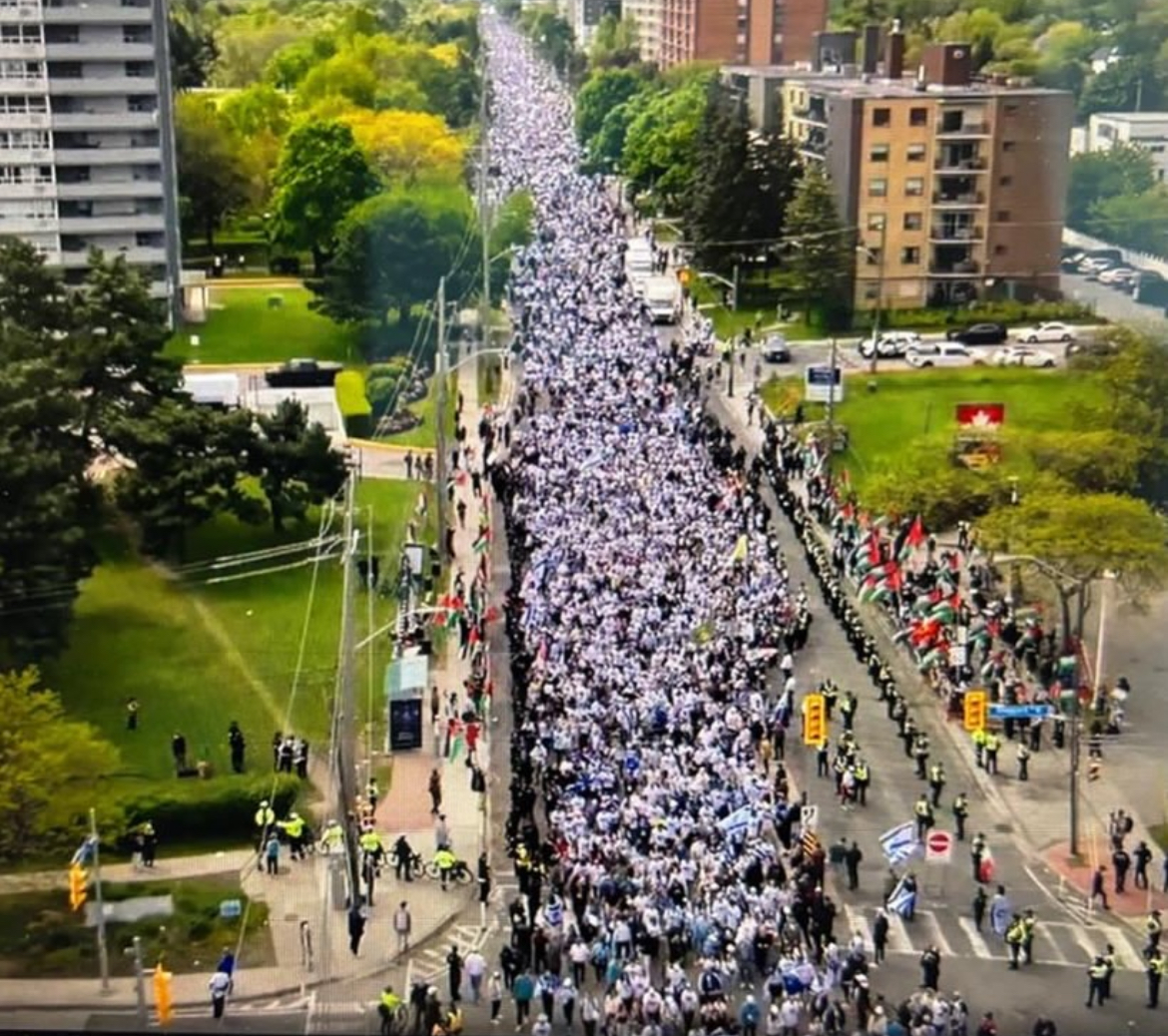
By GERRY POSNER There are walks and then there are walks. The Toronto UJA Walk for Israel on May 25, 2025 was one of a kind, at least as far as Canada and Jews are concerned. The number of people present was estimated to be 56,000 people or 112,000 total shoes. (How they get to that number is bewildering to me, since there is no one counting). This was 6,000 more than last year. Whether it is true or not, take it from me, it was packed. The synagogues in Canada should be so fortunate to get those numbers in total on High Holidays. The picture here gives you a sense of the size of the crowd.
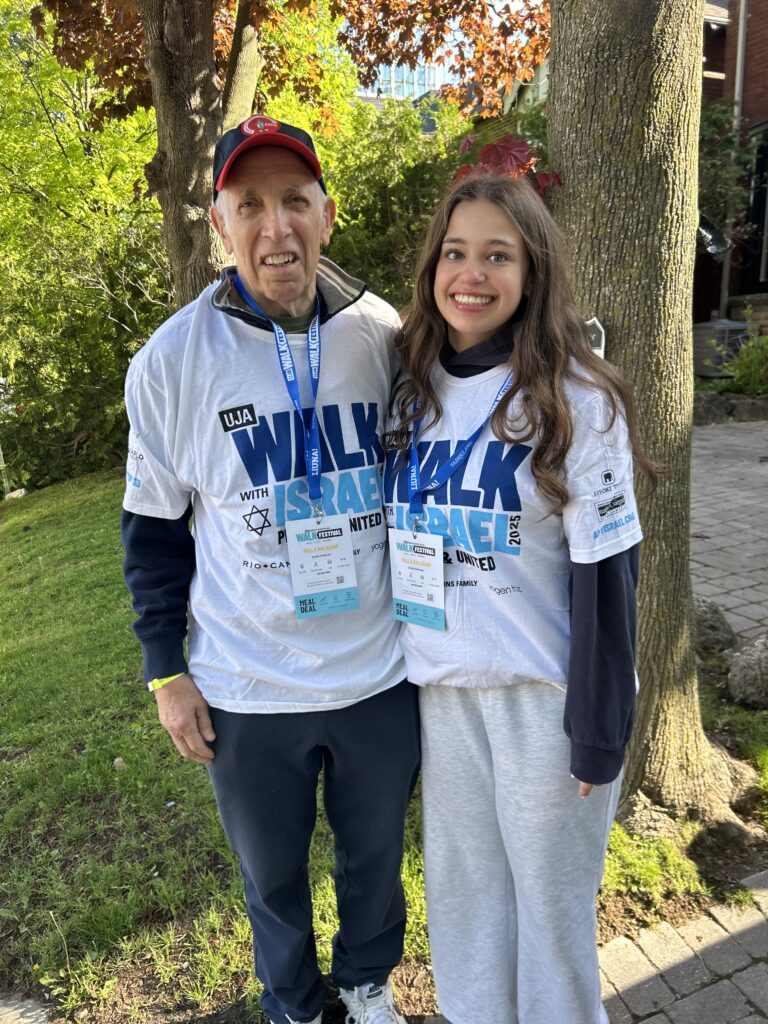
This was my first walk in Toronto for Israel and I was with my granddaughter, Samantha Pyzer (not to forget her two friends whom she managed to meet at the site, no small feat, even with iPhones as aids). The official proceedings began at 9:00 a.m. and the walk at 10:00 a.m. There was entertainment to begin with, also along the way, and at the finish as well. The finish line this year was the Prosserman Centre or the JCC as it often called. The walk itself was perhaps 4 kilometres – not very long, but the walking was slow, especially at the beginning. There were lots of strollers, even baby carriages, though I did not see any wheelchairs. All ages participated on this walk. I figured, based on what I could see on the faces of people all around me that, although I was not the oldest one on the walk, I bet I made the top 100 – more likely the top 20.
What was a highlight for me was the number of Winnipeggers I met, both past and present. Connecting with them seemed to be much like a fluke. No doubt, I missed la lot of them, but I saw, in no particular order (I could not recall the order if my life depended on it): Alta Sigesmund, (who was, a long time ago, my daughter Amira’s teacher), Marni Samphir, Karla Berbrayer and her husband Dr. Allan Kraut and family. Then, when Samantha and I made it to the end and sat down to eat, I struck up a conversation with a woman unknown to me and as we chatted, she confirmed her former Winnipeg status as a sister-in- law to David Devere, as in Betty Shwemer, the sister of Cecile Devere. I also chanced upon Terri Cherniack, only because I paused for a moment and she spotted me. As we closed in near the finish, I met ( hey were on their way back), Earl and Suzanne Golden and son Matthew, as well as Daniel Glazerman. That stop caused me to lose my granddaughter and her pals. Try finding them amid the noise and size of the crowd – but I pulled it off.
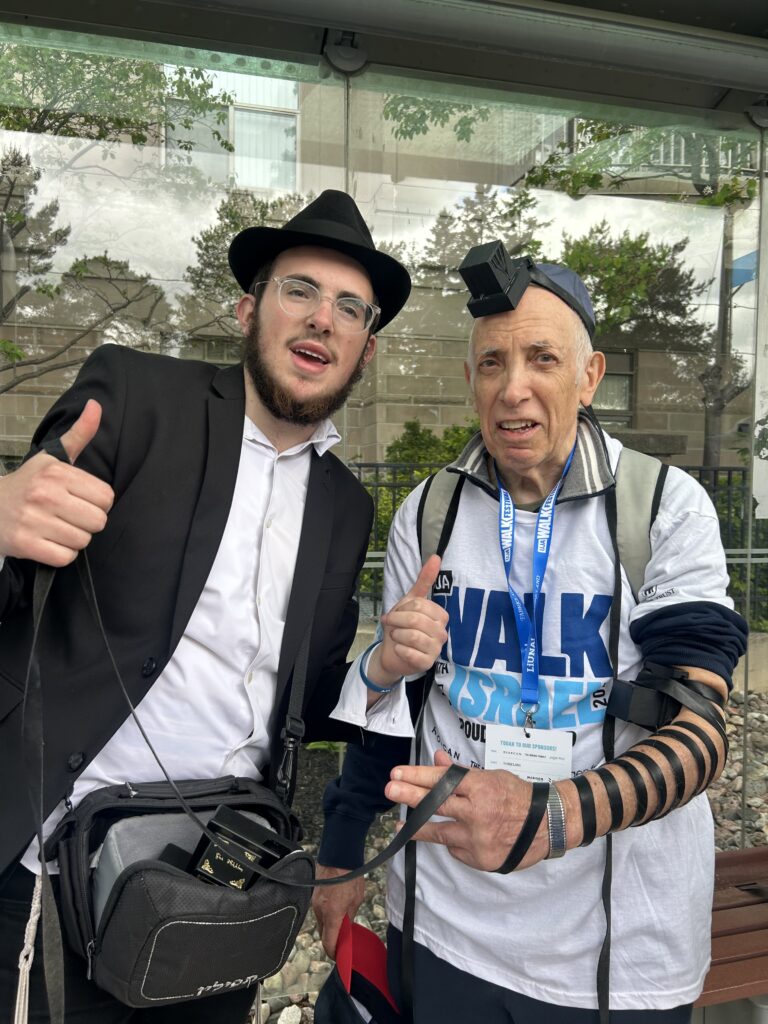
As I was in line to get food, I started chatting with a guy in the vicinity of my age. I dropped the Winnipeg link and the floodgates opened with “ Did I know Jack and Joanie Rusen?” So that was an interesting few minutes. And I was not too terribly surprised to come across some of my Pickleball family. All of these meetings, along with spotting some of my sister’s family and other cousins, were carried on with the sound of the shofar as we moved along the way. In short, this was a happening. Merchants selling a variety of products, many of them Israeli based, were in evidence and, of course, the day could not have ended without the laying of tefillin, aided by Chabad, who have perfected the procedure to take less than a minute. See the photo. Chabad had a willing audience.
Aside from the joy of sharing this experience with my granddaughter, the very presence of all these Jews gathered together for a common reason made this day very special to me. However, there was a downside to the day. The downside was that, as we began to walk back to our car there was no other way I could figure out how to return when the rains came and came. While we walked faster, we were impeded by pouring rain and puddles. But Samantha wanted to persevere, as did I. We made it, but were drenched. My runners are still drying out as I write this two days later.
What with being surrounded by 56,000 people, the noise, the slow walking, and the rain, I can still say the day was a real highlight for me – one of the better moments since our arrival in Toronto in 2012. As well as the photos we took along the way, I have the reminder of the day, courtesy of the UJA, as evidenced from the photo. It was not just the walk, but the talk that accompanied the walk that made it so worthwhile for me. I would do it again, minus the rain.
